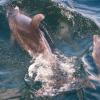Effect Of A Marine Reserve On The Distribution Of Coral Reef Fishes In Barbados
High population densities of larger fish within reserves could result in emigration of fish to surrounding non-reserve areas, producing a gradient of abundance and mean size across the reserve boundaries. The difference in fish abundance and size between reserve and non-reserve should be higher for sedentary than for mobile species and for highly catchable than for less catchable species. To test these hypotheses we estimated the abundance and size of fishes by trapping and visual census on fringing reefs in Barbados: 5 reefs within the 2.2 km of the Barbados Marine Reserve (BMR) and 8 reefs in the non-reserve (NR) area within 4 km of the reserve boundaries. The abundance of large, trappable size fish of all species combined was higher in the BMR than in the NR, but abundance of small, nontrappable fish did not differ between BMR and NR. Trap catches decreased gradually with distance from the BMR center, but this gradient of abundance was less evident in visual census counts of trappable size fishes of all species combined, and not apparent in trap or visual census estimates of abundance for individual species. Mean size was larger in the BMR than in the NR for 18 out of 24 species. The relative differences in both abundance and size between BMR and NR did not differ between mobile and sedentary fish taxa. However, for sedentary taxa, the relative differences in abundance and size increased with trappability (the vulnerability to traps, which are the most common fishing method). These patterns suggest that the BMR does protect the fish community from fishing mortality and that emigration rates are generally low. Trappability and mobility depend on complex behavioral characteristics of fishes and are potentially important for the functioning of marine reserves.
Area of Interest: Barbados
Year: 1996




